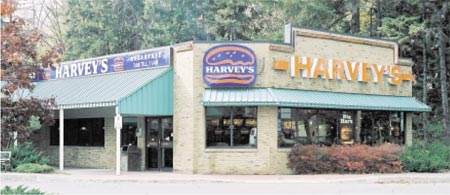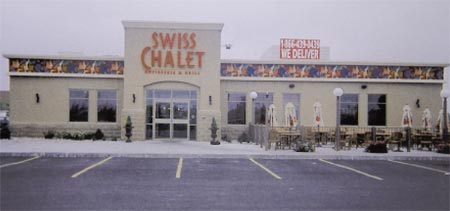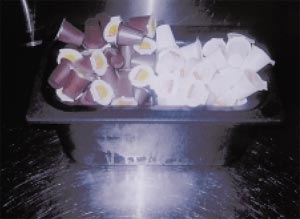Famz Foods: Restaurants Serving Up Energy Efficiency
Famz Foods: Restaurants Serving Up Energy Efficiency
Please note:
This publication may refer to programs that are no longer available. For current information, please visit ecoENERGY or contact us.

Tom Uz
Vice-President
Famz Foods Ltd.
Swiss Chalet and Harvey's Reducing Energy Use
The Swiss Chalet Rotisserie and Grill and Harvey's restaurants operated by Famz Foods Ltd. in southwestern Ontario offer more than friendly service and tasty food. They are also cooking up a healthy reduction in operating costs and greenhouse gas (GHG) emissions that contribute to climate change by cutting their energy use.

A Harvey's restaurant
Famz Foods operates 10 Swiss Chalet and four Harvey's restaurants in southwestern Ontario. Famz Foods founder, President and CEO Lee Zeytinoglu franchised his first Harvey's in 1975 in Sarnia, Ontario. Harvey's offers fast food and features charbroiled hamburgers. Swiss Chalet offers full-service casual family dining with a menu based on chicken and ribs.
“We must continuously look for ways to lower our costs so we can offer the greatest value to our guests,” Mr. Zeytinoglu says. “This is the thrust of our business.”
In 2000, Famz Foods joined the Energy Innovators Initiative (EII) of Natural Resources Canada's (NRCan's) Office of Energy Efficiency (OEE) that encourages Canadian businesses and institutions to reduce costs and GHG emissions by becoming more energy efficient. More than 1000 registered Energy Innovators have made commitments that will contribute to Canada's GHG emissions reduction target under the Kyoto Protocol, while saving money and energy.
Within a year of joining the EII, Famz Foods started reducing its energy use and developed an action plan with details on becoming more energy efficient. The main ingredients in its recipe for energy efficiency are upgrades to lighting; refrigeration; controls; and heating, ventilating and air conditioning (HVAC). After its plan is fully implemented, Famz Foods hopes to reduce its annual energy consumption by 20 percent, or 12 860 gigajoules (GJ). That would result in a reduction of 645 tonnes of carbon dioxide equivalent per year. This should save the company over $150,000 in energy costs annually.
“This is an opportunity not only to help the environment but also to reduce our operating costs,” says Famz Foods Vice-President Tom Uz, who is leading the company's efforts to become more energy efficient.
Famz Foods' Appetite for Energy Innovation
Even before Famz Foods signed up with the EII, the company was well ahead of the curve in terms of energy efficiency. Its annual energy intensity in 1999 was 7.01 GJ/m2, compared with the industry average of 9.80 GJ/m2. Its target energy intensity is 5.61 GJ/m2.
Joining the EII helped Famz Foods become more aware of the opportunities to cut costs by reducing energy use. The EII offers information on everything from technical equipment retrofits to training staff about energy efficiency. As far as Mr. Uz is concerned, energy efficiency is good for the environment, but it's also good for his company's bottom line.
“We're trying to combat rising costs in the energy marketplace by reducing our consumption,” Mr. Uz says. “We've attacked energy use because it was our highest rising cost. Energy costs keep going up, but we can't keep raising our food prices.”
Financial assistance from the EII is helping Famz Foods afford retrofits that won't recoup their costs through energy savings until after four to seven years. “The assistance eases the blow. Some of the retrofits are a substantial investment,” says Mr. Uz.
A Recipe for Energy Savings
After Famz Foods joined the EII, the company realized that it needed to set clear targets to become as energy efficient as possible. It hired a professional energy consulting firm to help create its Energy Management Action Plan, which lays out ambitious energy-saving targets and the steps needed to reach them.
Before the plan was developed, Famz Foods' energy-saving measures were implemented sporadically. These measures were also not monitored or measured. Working with the energy consultant has allowed Famz Foods to focus its efforts and develop procedures and guidelines to operate more efficiently.
“The plan helps make sure we do it properly, rather than on an ad hoc basis. There is more continuity to our efforts to save energy, and there are more measurable outcomes,” says Mr. Uz. “Instead of having me trying to figure out what lights to use by calling someone at a lighting store, I can rely on the consultant's expertise to bring down real costs.”
Famz Foods' action plan makes it clear that over the long run, energy savings turn into cost savings. If one piece of equipment costs $500 more than another but the extra cost can be recovered within 12 months of energy savings, then the higher-priced piece of equipment becomes a money-saver in the long run.
As an added bonus, writing an action plan with a recognized energy consultant means Famz Foods was able to get insurance for the energy efficiency investments it makes.
“If we don't realize the expected savings through the initiatives in the plan, the insurance will cover it,” says Mr. Uz. “We could not get that insurance on our own.” Famz Foods' action plan won “best new submission” when it was registered with Canada's Climate Change Voluntary Challenge and Registry Inc. (VCR Inc.), a non-profit partnership between industry and government. VCR Inc. said that the Famz Foods' plan demonstrated “exemplary senior management commitment to GHG reduction through ambitious energy conservation targets.”
To manage the implementation of Famz Foods' action plan, the company created a committee called Conservall. It includes management from each region of the chain and encourages input and suggestions from all restaurants. Conservall evaluates energy efficiency options, creates energy policies and reviews progress made toward energy targets.
The table below presents a partial list of energy retrofits that Famz Foods is planning to implement.
| Activity | Projected Energy Savings | Projected Cost Savings |
Projected Emissions Reductions |
|---|---|---|---|
|
Lighting retrofit with fluorescent or compact fluorescent lighting and electronic ballasts in applicable areas Upgrade lighting controls |
935 GJ | $18,300 | 47 tonnes |
| Controls for dining room air-handling units | 1050 GJ | $12,700 | 53 tonnes |
| Controls on kitchen exhaust and make-up air | 2050 GJ | $19,900 | 102 tonnes |
| High-efficiency domestic hot water boilers | 1680 GJ | $14,100 | 84 tonnes |
Swiss Chalet Pilot Retrofit Project
Famz Foods is focusing retrofit efforts on its Swiss Chalet franchise in London, Ontario, with financial assistance for energy retrofits from the EII. After energy efficiency improvements have been established and measured, they will be replicated in other Famz Foods restaurants.

A Swiss Chalet restaurant
At the Swiss Chalet in London, lighting retrofits have resulted in annual energy savings of 10 087 kilowatt hours (kWh) (36 GJ), or about $736 per year. At a cost of $4,491, these retrofits should pay for themselves in just over six years. Three 60-watt incandescent spotlights at the front entrance were replaced with 20-watt compact fluorescent bulbs. In the kitchen and storage areas, 55 surface-mounted fixtures of two T-12 fluorescent bulbs and electromagnetic ballasts were replaced with the same number of T-8 fluorescent bulbs and electronic ballasts. In the public washrooms, four fixtures of T-12 fluorescent U-tubes with electromagnetic ballasts were replaced with T-8 fluorescent U-tubes and electronic ballasts.
The restaurant's water heater was replaced with a high-efficiency condensing boiler with a thermal efficiency of 94 to 97 percent. Because the restaurant uses a substantial amount of hot water for food preparation and dishwashing, this retrofit is saving 5074 m 3 of natural gas, $1,674 and 189 GJ per year.
Famz Foods has also installed energy-saving digital controls, such as timers to shut off public washroom exhaust fans. The public washroom exhaust fans formerly operated on the same schedule as the kitchen ventilation equipment – they were turned on by the first person to arrive and shut off by the last person to leave. This meant that they operated for at least six extra hours each day. Now timers are set so that the exhaust fans operate only when the restaurant is open to the public. This saves 1384 kWh (56 GJ) of electricity per year, or $101. With a cost of $180, the payback period for this retrofit is 1.78 years.
Substantial energy savings were also found by installing a variable speed drive on the kitchen make-up air unit and by interlocking the operation of the kitchen exhaust fan with the burner. Before the retrofit, the first person to arrive at the restaurant would turn on the make-up air unit and all exhaust fans. This equipment was kept running until the last person left the premises, even though the amount of cooking drops significantly after the lunch rush and again after dinner. Using a variable speed drive on the kitchen make-up air unit and having fans turn off when burners are turned off will save 11 942 m3 (445 GJ) of gas a year and 11 285 kWh (41 GJ) of electricity a year, for a total dollar saving of $4,765. At a cost of $19,800, these retrofits will have a payback period of 4.16 years.
Famz Foods is also upgrading the restaurant's HVAC system. Programmable thermostats were the first step toward running the heating and air conditioning as efficiently as possible. The building cools down when unoccupied at night, but the temperature change is controlled and gradual. If the proper controls were not in place, setting a lower nighttime room temperature could trigger the air conditioning to come on to make a room meet this temperature.
The restaurant is also replacing its two 20-year-old rooftop air-handling units with super-high-efficiency HVAC units. The units have to be special-ordered because they are a grade above high-efficiency units that are available off the shelf.


* Commercial Building Incentive Program – Program and Technical Guidelines for the Commercial Food Service Sector, prepared by Finn Projects for NRCan, July 1998, page 5.
Note: Fast food restaurants generally consume less energy for sanitation than full-service restaurants because the food packaging and cutlery are disposable.
Empowering Employees
Although Famz Foods is committed to technical improvements that will increase the level of energy efficiency in its restaurants, the company also recognizes that its employees have an important role to play in reducing energy consumption. Many energy-saving measures depend on employee support. In order to get this support, Famz Foods is teaching its employees about the importance of saving energy and how to become more energy efficient.
Famz Foods is spreading the word about energy efficiency to employees through a mix of training, communications on bulletin boards, newsletters and incentives. The Conservall committee is developing an annual award to recognize the general manager whose restaurant is the most energy efficient. Also, 10 percent of the evaluation for the employee-of-the-month award at each restaurant now covers energy awareness. This includes criteria for following daily routines and start-up checklists designed to save energy. Employee-of-the-month winners receive gift certificates for restaurants or for going shopping.
“It certainly has created more awareness,” says Mr. Uz. “Before, it was a free-for-all, with employees turning on all the lights when they came in early. Now people are more conscious of doors being left open or lights being left on.”
Employee awareness has an added upside: employees are coming up with their own suggestions for saving energy. And who better to make these kinds of recommendations than the people who actually work in the restaurants?
“It's coming from them now. And even little things count,” says Mr. Uz. “For example, we've had recommendations to change an incandescent from 40 or 60 watts to 30 watts, or removing a fixture altogether if it's not really needed.”
One staff recommendation prompted the installation of timers on lights and air exhaust fans in staff washrooms. Another employee suggested replacing the small “side stand” refrigerators, where servers keep cream and butter so they can quickly stock their tables in the Swiss Chalet restaurants. Instead, the restaurants now have thermal units that go in the main freezer overnight, then stay cold at the side stand during the day. Replacing six small refrigerators saves $2,790 in electricity costs every year and eliminates future maintenance costs for these units.

Thermal units for creamers
“It's not a lot of money, but small changes add up. And there are no longer any service calls for those fridges,” Mr. Uz says.
Energy and Cost Savings Stem From Quality Equipment
At Famz Foods, purchasing policies now incorporate energy efficiency as a selection critera wherever possible. When a piece of equipment nears the end of its life cycle, Famz Foods researches the most energy-efficient replacement.
“We shop around, not just for the best price, but for the best piece of equipment,” says Mr. Uz. The two new, high-efficiency rooftop HVAC units that are being installed at the Swiss Chalet in London each cost $3,500 more than a standard unit. Because of this additional cost, the payback time in energy savings will be 6.7 years.
“But that doesn't include the lower repair and maintenance costs that result from buying better equipment,” says Mr. Uz. “Because we have better equipment, we don't need as many service calls. By year seven, we hope to be substantially ahead.”
Following the same reasoning, Famz Foods has switched almost all its deep fryers to high-efficiency fryers that use less gas to stay hot. These gas fryers also have a lifetime guarantee on their fryer pots.
“Even though we're spending $2,000 instead of $900, we don't have as many service calls, if any,” says Mr. Uz.
Another cost that must be factored in when considering retrofits is whether a piece of equipment needs to be repaired or replaced. When refrigeration systems in restaurants in London and Kitchener needed expensive repairs, Famz Foods decided to opt for new units.
“They were due for repair; but instead of repairing them, we replaced them with units that are air-cooled rather than liquid-cooled,” says Mr. Uz. “They use less energy, and we're going to reduce our water consumption.”
A Full Menu of Energy Efficiency
With everything ranging from low-wattage light bulbs to high-efficiency fryers, Famz Foods' menu of energy efficiency measures is extensive. It has already led to impres-sive cost and energy savings. Replicating the energy efficiency measures from the Swiss Chalet pilot project in London should help the company reach its target energy intensity of 5.61 GJ/m2. In fact, even though Famz Foods plans to expand by two more Swiss Chalets in the next few years, its total energy consumption in 2010 is projected to be lower than in 1999, when the company had fewer restaurants.
“Famz Foods is committed to being a part of Canada's solution to climate change,” says Mr. Uz. “Our investment in energy efficiency will enable us to reduce our operating costs and at the same time meet our commitments to the EII and VCR Inc.”
You can find other buildings publications from the Office of Energy Efficiency. To order paper copies, or to discuss how we can help you make your property more energy efficient, please contact us.
Buildings DivisionOffice of Energy Efficiency
Natural Resources Canada
580 Booth St., 18th floor
Ottawa ON K1A 0E4
Tel.: 877-360-5500 (toll free)
Fax: 613-947-4121
Web site: http://www.nrcan.gc.ca/energy/efficiency/eefb/buildings/13556
Tom Uz
Vice-President
Famz Foods Ltd.
1273 London Road
Sarnia ON N7S 1P3
Tel.: 519-383-7900
Fax: 519-383-7565
E-mail: info@famzfoods.com
Web site: www.famzfoods.com
Page details
- Date modified: